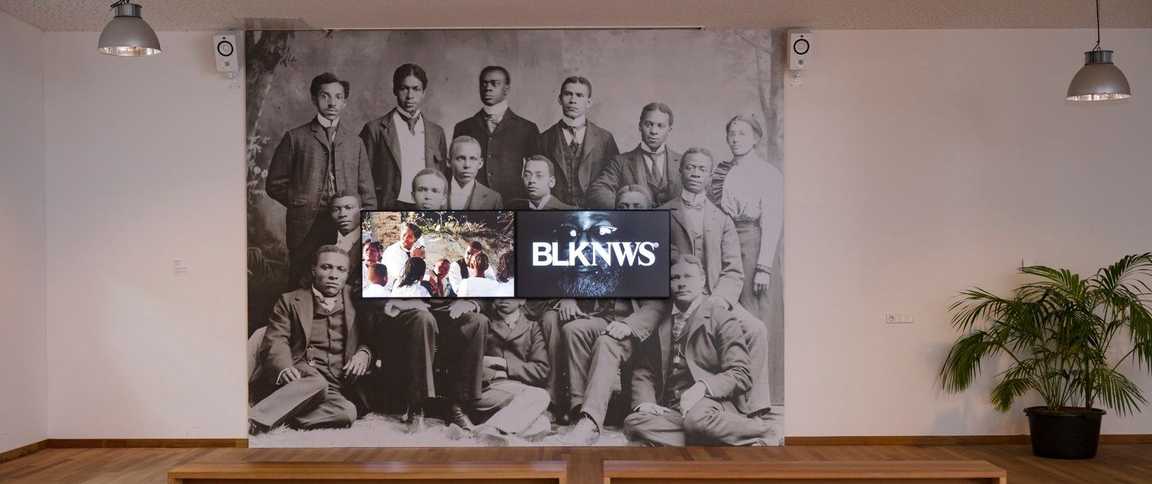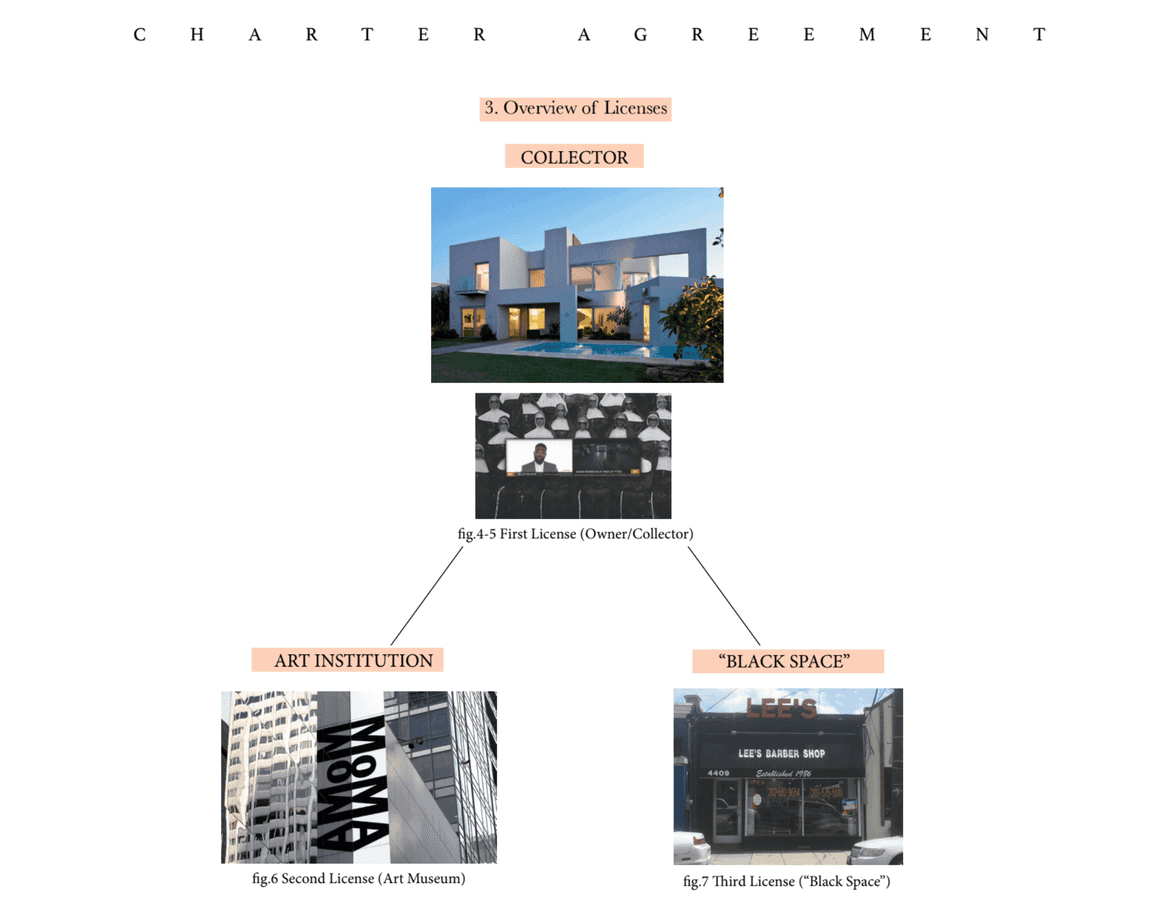
BLKNWS® (2018) - Kahlil Joseph
In the collection of the Bonnefanten Museum.
The main challenges facing BLKNWS® revolve around its dependency on the proprietary technology, BrightSign, as display and distribution method. BrightSign offers a video player that streams video material uploaded through the supporting program BrightAuthor from the cloud. This method of display and distribution required the revaluation of what the museum had actually purchased and what should in the end be preserved.
Brief Description of the Work
BLKNWS® Original Variations (Unique Variant #6), is one variation of the ten that make up Kahlil Joseph's fugitive television broadcast, BLKNWS®. It is a continuously updated newscast that assembles historical and contemporary found footage with newly created scenes that make use of a newsroom format. For presentation, two juxtaposed flat screens play corresponding digital video files that are in dialogue with one another. In addition to the two-channel display, BLKNWS® is presented against a photographic backdrop consisting of a specific wallpaper that features a historic portrait of black people employed in professions typically associated with white people. For this specific Variant, this is composed of a group of students (Roger Williams University, Nashville, Tenn., Academic class, 1899).
BLKNWS®: Exhibition and Acquisition
The work is part of a group of ten variants created by Joseph as artwork manifestations of what he considers the bigger enterprise that is BLKNWS®, the media entity. BLKNWS® Original Variations (Unique Variant #6) has three licences that allow the work to live in accordance with its community-based principles. These effectively enable the collector to participate in shaping the future of the artwork in an active collaborative effort. The work enacts these principles by requiring licences for two black-owned cultural spaces every time a collection shows their variant, thereby creating the opportunity for widespread dissemination and public engagement with diversified audiences.
BLKNWS® was conceived of as a cable news programme and was always intended for a broader audience. It found a place in the art world with presentations in art galleries, museums and biennials. Described as one of the best artworks presented at the 58th Venice Biennial, the work also touches on diverse dissemination, being shown in black-owned markets, hotel lobbies, and barbershops. BLKNWS® belongs in all these worlds, amid numerous calls for BLKNWS® to become an actual television network, which seems likely.
When Bonnefanten acquired the work in 2019, six BrightSign LS424 media players pre-programmed by the artist were delivered, as well as documentation concerning the work’s installation and licensing. Two of these media players were delivered to LI-MA and included one micro-SD card each, containing several files of code, logs, screenshots and video files.
BLKNWS®’ Licensing Scheme
After acquisition, the Bonnefanten obtained the right to exhibit the Unique Variant #6 in its institutional space, as well as the obligation to show the work in two black-owned spaces simultaneously. These were previously selected on the occasion of the artwork’s exhibition in 2021 as OSCAM in Amsterdam and the Hiphophuis in Rotterdam.

Licensing scheme for "BLKNWS® Original Variations"
Characteristics of Proprietary Software and Hardware
To utilise the BrightSign media players, an annual subscription must be paid by the institution in ownership. The artist studio programmes the footage and uploads the video content to each player in BrightCloud, an Amazon Web Services (AWS)-hosted cloud service, via the interface BrightAuthor. The media players, when connected to the internet, download the last uploaded file from the cloud, as scheduled via BrightAuthor. The installation setup is done by connecting each player to the internet and to a flat screen each via HDMI. Both BrightSign players need to be connected to power simultaneously in order to sync using the company’s video wall feature, BrightWall. BLKNWS® Original Variations (Unique Variant #6) is dependent on an internet connection. If this connection is interrupted it will play the last downloaded video content. The video format is mp4 with a variable duration; those accessible videos downloaded on the BrightSign LS424 players were found to have a duration under 30 minutes.
Understanding the Artwork's Vulnerabilities
Any extensive preservation strategy for a contemporary artwork often requires active participation on the artist’s side. In the artist's own words, “Art at its best is unstable”, in effect referring to this characteristic of unstableness as one of the conditions for great art and as a result perfectly describing his approach to the BLKNWS® project.
Three layers of vulnerability for the work have been outlined, as follows:
1. A Social Layer - The work cannot be updated and conveyed as the 'live feed,' intended by the artist, without the network of contributors and editors that support it, especially because so far it has not been possible to reach the artist in order to discuss his plans to ensure the continuity of this primary layer. Additionally, the new content uploads are done without the institution's awareness.
2. A Proprietary Layer - The conditions for the work to be updated and played rely on the BrightSign subscription and on the continuity of BrightSign. More so, BrightSign is adding an additional proprietary layer through its use of AWS. The artist’s use of BrightSign means that the institution cannot ensure the preservation of the work without the artist's cooperation.
3. A Spatio-Temporal Layer - the video content changes according to the different venues where it is shown. There seems to be evidence of the incorporation of specific footage according to where it was installed, but this has not yet been confirmed.
In view of this, the main questions to the artist related to how he sees this artwork’s legacy on the video feed and editing side, but also on the dependency on BrightSign and whether there are alternatives.

Photo by Jeff McLane
Conservation Measures
To address the vulnerabilities, some conservation measures were recommended to the museum. These included preserving the ‘Original Program’ of BLKNWS® Original Variations (Variant #6) in LI-MA's Digital Repository. Additionally, it was advised to document other collectors’ Variants as completely as possible, and save video content updates for documentation purposes. This last point is relative to the content that is shown in each exhibition and is not a recommendation from the artist, as it is not the artwork, and would exist as research material only. A further recommendation to bring to the artist’s consideration is related to the use of AWS. This chain that connects BrightAuthor to the BrightSign player can be broken if AWS no longer exists. Files saved in the cloud could be lost. Given the artist's socio-political engagement, other open-source Cloud options would provide a more ethical, conscious method of executing the same effect. This could also improve the sustainability of the work without affecting its aesthetic.
Additional Conservation Measures - Public Program
To address BLKNWS®' foremost vulnerability, its community-based process of production, a future public program was outlined by LI-MA, including the presence of the artist. An exhibition of BLKNWS® in several venues in the spirit of the "Made in L.A." city-wide exhibition, will be the departing point for a programme of talks, conferences, and other public initiatives. A funding application will be submitted to the U.S. Embassy in the Hague and to additional funding institutions. Partners to be associated with the Bonnefanten and LI-MA will ensure a successful dissemination of the BLKNWS® enterprise and its social effects.
Research by LI-MA team in collaboration with: Charlotte Franzen (Head of Collections, The Bonnefanten Museum), Charlotte Fijen (Collections Assistant, The Bonnefanten Museum), Mirjam Meisen (Collections Registrar, The Bonnefanten Museum), Carlo van den Brand (Audiovisual Technician, The Bonnefanten Museum), Kahlil Joseph (Artist), Sylvia Herbold (BLKNWS® Studio), Antonio Buyard (BLKNWS® Studio) and Francisca Sousa (PhD intern, LI-MA)








